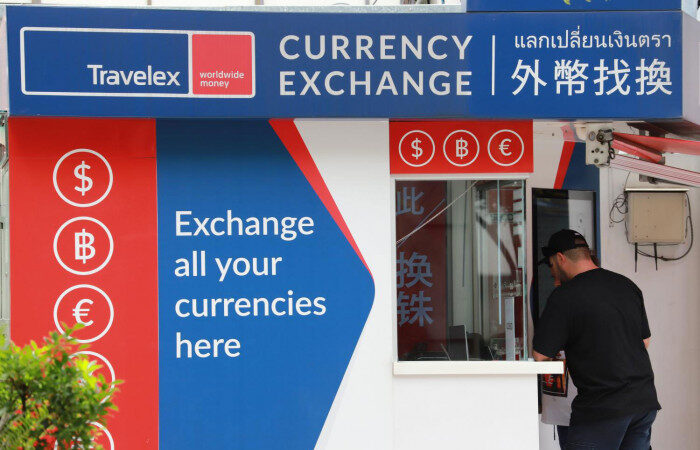

The health of Asian currencies has been making headlines lately. The Japanese yen has depreciated to the lowest in 38 years at 160 to the dollar, leading to reports that the Bank of Japan is signalling moves to reduce liquidity and possibly continue raising interest rates to control inflation and stop the depreciation.
Other Asian currencies also weakened sharply as the dollar has strengthened. The Philippine peso, Korean won and Indian rupee are near historic lows, while the central banks of India, Vietnam and Indonesia have been intervening in the foreign exchange market to support their currencies.
Also down by a range from 3.2% to 12.2% since the start of this year are the euro, Canadian, New Zealand and Taiwan dollars, Indonesian rupiah, Swiss franc, Mexican peso, Turkish lira, Argentine peso and Brazilian real.
The baht is near the middle of this range, having weakened by 6.5% to around 36.90 per dollar.
The main reason for this weakness is the US economy is still stronger than expected, leading many to believe that interest rate cuts in the US may be slower and smaller than in other countries.
The US economic picture, as measured by the Purchasing Managers’ Index (PMI), is still quite strong compared with other economies such as Europe, where increasing political concerns are weighing on the economy.
In the US, the S&P Global composite PMI rose to 54.6 in June from 54.5 in May, the highest in 26 months, while the euro-zone PMI fell to 50.8 from 52.2.
The reading in France dropped to 48.2 as markets fear political gridlock following a snap election that President Emmanuel Macron’s party is expected to lose.
In Japan, the PMI dropped to 50.0 in June, with the services index contracting for the first time in nearly two years from higher raw material costs for companies following the sharp depreciation of the yen.
India is one of the few bright spots, with the PMI rising to 60.9 from 60.5.
SYNCHRONISED RECOVERY
In the big picture, the world economy is showing signs of a synchronised recovery, starting from the large economies in North America, Europe and Asia. The latest global PMI has improved, especially in Asia where there are clear recovery signs, similar to the period from 2016-18.
Yet it cannot be denied other economies are more at risk. Political risk is a concern in India, where Prime Minister Narendra Modi was unable to secure an outright majority in the recent election, meaning he may struggle to pass all his economic reform measures.
France saw a huge bond sell-off after President Macron called elections three years before they were due, after far-right parties surged in European parliament elections.
Geopolitical risks in countries other than the US are partly causing assets elsewhere to be sold off, with investors turning to the dollar as a safe-haven asset.
Moreover, divergence between monetary policy in the US and elsewhere is a factor. The global interest rate cycle is entering a downward trend.
In the rich world, central banks have started reducing policy rates. Switzerland (two cuts already), Canada, Sweden and the euro zone have all begun easing, while the Bank of England is expected to follow suit in August.
But the picture is different in the US. While key indicators such as retail sales, durable goods orders and first-quarter GDP have weakened, the economy is still stronger than anywhere else, and inflation remains higher than elsewhere.
US inflation is 3.3% compared with 2.6% in the euro zone, and the Fed is expected to cut rates just once or twice this year. Higher rates continue to attract investors and boost the dollar.
We predict the baht will weaken further to 37.50 per dollar in the third quarter on the strength of the dollar and the US economy. But as the US economy begins to show signs of slowing down at the end of the third quarter, the dollar will depreciate.
The market is beginning to think the Fed will reduce interest rates, allowing the baht to strengthen in the fourth quarter, with the Thai current account in balance (from a trade deficit, but with a surplus in services), with the baht possibly strengthening sharply to around 34.50.
YEN OUTLOOK
Meanwhile, the yen is likely to weaken based on the interest rate difference with the US. However, we expect after the Bank of Japan tightens liquidity and raises interest rates in the third quarter, the yen will strengthen in the fourth quarter.
Chinese authorities are likely to allow the yuan, currently down 1.7% this year, to depreciate slightly to help the economy.
A weak yen and yuan will put pressure on the baht to continue depreciating over the next one or two months. Baht volatility will increase given market perspectives on the direction of US monetary policy.
Although we expect the dollar will continue to strengthen in the third quarter before depreciating, nothing is certain. Global currencies will continue to fluctuate more depending on the direction of the economy, inflation, global geopolitical trends and domestic politics.
In the US, a close presidential race between Joe Biden and Donald Trump adds yet another level of volatility.
Businesspeople and investors whose transactions involve international currencies must be vigilant and strictly hedge currency risk.
